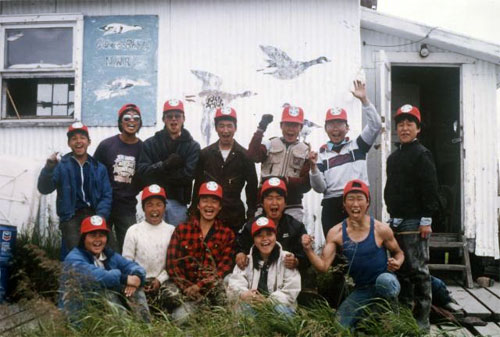
Biologist creates legacy at village goose campBy NED ROZELL November 30, 2013
The U.S. Geological Survey biologist has executed on that project, working with talented colleagues to create a book with pictures of dozens of smiling teenagers from the small western Alaska village of Chevak. The children helped biologists gather and band geese and swans each August from 1986 to 2010. The lovely volume shows a rare long-term collaboration between villagers and scientists who were there to look at the problem of declining numbers of geese returning to the Yukon-Kuskokwim Delta in the 1970s and 1980s.
Kids from the village of Chevak who were part of a bird-banding crew at Old Chevak in August 1988. This photo is a part of a yearbook compiled by biologist Craig Ely, who orchestrated the camp for 25 years.
The book features a quarter century of kids aged 13 and older from the small Cu’pik-speaking village of Chevak. The children each spent a few days at the abandoned village site of Old Chevak helping Ely and other biologists round up flightless birds so the researchers could band them. The scientists wanted to see where the geese and swans went during the times they weren’t in Alaska, to mark them to see if they stuck around the site when they were here, and to count how many babies they produced. In 1986, Ely began taking group photos of about a dozen village teens who helped at the camp each summer. For more than two decades, until the camp ended in 2010, he faithfully snapped that picture. The bird-banding camp was held at the Old Chevak town site, a two-hour boat ride from new Chevak, which had a population of about 500 when the study started and is now home to about 1,000. The old town site includes one building in good shape — the church of the old village. The camp allowed biologists to conduct research on the large waterfowl species that people in the area had caught and eaten for centuries. Old Chevak is a great site for capturing geese and swans because the birds molt there. Birds don’t fly at that time, so researchers and kids could drive them into corrals like cattle. Scientists then fitted the birds with metal leg bands, high-visibility neck collars or satellite transmitters. Interested kids signed up for the research camp on a notebook at the Wayne Hill Store in Chevak. Ely, whose three children and wife joined him at the camp several times, split the camp up into two crews that would stay three or so days apiece. When the day came to gather the Chevak kids for their adventure, he called them down to the boat launch using a CB radio. “Once the word got out that it was the thing to do, it was hard to turn people away,” Ely said. “We had a lot of kids come back several times, and then the kids of kids.” Helping Ely since 1986 were many guest biologists who would take a few kids apiece out in skiffs and drop them off in strategic places to drive birds into a pen. The rise of tundra known as Old Chevak is not just a spectacular place for birds; it’s a special place for Ely and a significant spot for the villagers. “It’s where these people used to live,” he said. “It’s their grandparents’ hunting ground, part of their history.” Noticing fewer geese returning to the Yukon-Kuskokwim Delta a few decades ago, local elders got together with federal and other officials from as far as California, where some of the birds spend the winters. Then began a long effort of limiting or stopping hunting and egg gathering at key times all along their migration routes. At the long-term study site at Old Chevak, Ely, the biologists and the kids captured and banded cackling geese, white-fronted geese, emperor geese and black brant. The numbers of each of those birds has increased since 1984. Their recovery is the reason the Old Chevak camp for kids ended in 2010. “We had reached most of our research objectives,” Ely said. “Cackling and white-fronted geese had recovered, so the fire had kind of been put out.” Besides touching the lives of dozens of Chevak kids, the Old Chevak camp experience produced some nice science. The book features maps that show the migratory path of all the species of birds they studied there. Tundra swans, for example, have taken off from Old Chevak in the fall, veered to Saskatchewan, then headed back southwestward to northern California, where they spend the winter. Other things that surprised Ely were the efficiency of arctic foxes, which some years ate all the eggs of the cackling geese, and that in years of high nesting success, goslings often grew slower because of the increased competition for food. He was also surprised at how in the early years of the project the Chevak kids had a strong local accent, as Cu’pik was their first language at home. In later years, kids had no accents because they spoke English at home. To those children, many of whom are now adults, Ely will mail copies of the 94-page, full color book. “Every kid (and former kid) in Chevak’s going to get one,” he said. “The main thing is an acknowledgement of the kids and to put a feather in the cap of Chevak for helping to co-manage their resource.”
E-mail your news &
photos to editor@sitnews.us
|
||
